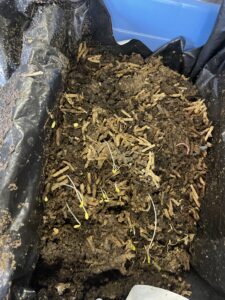Composting is a critical step in keeping our environment clean and healthy in the long run. Are you worried about mold in your compost? Have you ever glanced into your compost bin to see an array of colors – green, blue, pink, red, and white mold speckling your compost pile? Don’t worry; it’s not only normal, but it’s also an integral part of the composting process.

Mold, a type of fungus, works in harmony with bacteria aiding in the breakdown of your food wastes. When you spot mold, it’s an indication of a robust, functioning compost system. While some people fear the sight of these fungal formations, most are entirely harmless and serve the essential role of breaking down more complex materials that bacteria alone cannot handle.
types of mold
There are varieties of molds that you may encounter in your compost, each with distinct appearances and purposes. The vibrant yellow Fuligo septica, more commonly known as slime mold or scrambled egg slime mold, is one such example. Its other forms, white, gray or purplish-brown, are all non-hazardous and beneficial for your composting process.
Another typical mold type is green mold, which can act as your moisture indicator. When you see an abundance of green mold, it’s a sign your compost is too wet. To correct this, increase dry material, water less, or cover during heavy rain periods.
You might also encounter Bird’s Nest Fungus, which, as the name suggests, appears as tiny bird’s nests nesting within your compost pile. They are especially good at breaking down woody materials in your compost pile.

Having said this, let’s not forget the importance of balance in composting. In some cases, the presence of too much mold, or a foul smell, can be an indication of an unbalanced compost pile. This can be due to a lack of air distribution within the pile or excessive moisture. To restore balance, add dry organic materials and aerate the compost pile by giving it a good mix.
Furthermore, molds naturally present in composting systems, particularly blue molds, belong to the Penicillium family. These molds are common and harmless, especially on fruits. They are efficient decomposers, helping to speed up the composting process by breaking down organic matter quicker and more effectively.
While molds are a natural part of the composting process, precautions need to be taken around them. It is advisable to refrain from inhaling mold spores, especially during compost turning and if you have any allergies or respiratory conditions. It’s also essential to keep pets away from the compost pile as mold consumption can lead to sickness in animals.
So, the next time you see moldy food, remember it’s perfectly fine to toss it into your compost bin. Not only is it okay, but it can also be beneficial, introducing those essential fungi that accelerate the breakdown of other compost ingredients. Exceptions to this rule are for Bokashi composting, where you wouldn’t want to add moldy food. Also, avoid adding moldy meat, fish, or dairy into your compost as these can attract pests.
In summary, molds in your compost are not something to be alarmed about. In fact, they play an integral role in the organic decomposition process. So next time you spot a fungi flourish of colors in your compost bin, know that your compost is working exactly as it should be!
If you found this information helpful, please share it! Tag Worm Wrangler Canada on your socials. And comment below with your questions!
